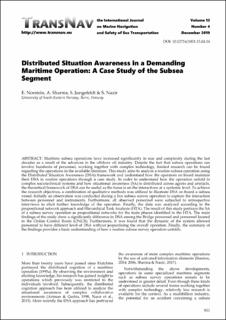| dc.contributor.author | Norstein, Erlend | |
| dc.contributor.author | Sharma, Amit | |
| dc.contributor.author | Jungefeldt, Sophie Sara Margareta | |
| dc.contributor.author | Nazir, Salman | |
| dc.date.accessioned | 2020-03-26T07:16:42Z | |
| dc.date.available | 2020-03-26T07:16:42Z | |
| dc.date.created | 2020-01-14T15:43:40Z | |
| dc.date.issued | 2019 | |
| dc.identifier.citation | TransNav, International Journal on Marine Navigation and Safety of Sea Transportation. 2019, 13 (4), 811-822. | en_US |
| dc.identifier.issn | 2083-6473 | |
| dc.identifier.uri | https://hdl.handle.net/11250/2648712 | |
| dc.description.abstract | Maritime subsea operations have increased significantly in size and complexity during the last decades as a result of the advances in the offshore oil industry. Despite the fact that subsea operations can involve hundreds of personnel, working together with complex technology, limited research can be found regarding the operations in the available literature. This study aims to analyze a routine subsea operation using the Distributed Situation Awareness (DSA) framework and understand how the operators on board maintain their DSA in routine operations through a case study. In order to understand how the operation unfold in complex sociotechnical systems and how situational awareness (SA) is distributed across agents and artefacts, the theoretical framework of DSA can be useful as the focus is on the interactions at a systemic level. To achieve the research objectives, a combination of qualitative methods was utilized to illustrate DSA on board a subsea vessel. Initially an observation was conducted during a live subsea survey operation to capture the interaction between personnel and instruments. Furthermore, all observed personnel were subjected to retrospective interviews to elicit further knowledge of the operation. Finally, the data was analyzed according to the propositional network approach and Hierarchical Task Analysis (HTA). The result of this study portrays the SA of a subsea survey operation as propositional networks for the main phases identified in the HTA. The main findings of the study show a significantly difference in DSA among the Bridge personnel and personnel located in the Online Control Room (ONCR). Furthermore, it was found that the dynamic of the system allowed personnel to have different level of DSA without jeopardizing the overall operation. Finally, the summary of the findings provides a basic understanding of how a routine subsea survey operation unfolds. | en_US |
| dc.language.iso | eng | en_US |
| dc.rights | Navngivelse-Ikkekommersiell 4.0 Internasjonal | * |
| dc.rights.uri | http://creativecommons.org/licenses/by-nc/4.0/deed.no | * |
| dc.title | Distributed situation awareness in a demanding maritime operation: A case study of the subsea segment | en_US |
| dc.type | Peer reviewed | en_US |
| dc.type | Journal article | en_US |
| dc.description.version | publishedVersion | en_US |
| dc.source.pagenumber | 811-822 | en_US |
| dc.source.volume | 13 | en_US |
| dc.source.journal | TransNav, International Journal on Marine Navigation and Safety of Sea Transportation | en_US |
| dc.source.issue | 4 | en_US |
| dc.identifier.doi | 10.12716/1001.13.04.14 | |
| dc.identifier.cristin | 1772706 | |
| cristin.ispublished | true | |
| cristin.fulltext | original | |
| cristin.qualitycode | 1 | |

